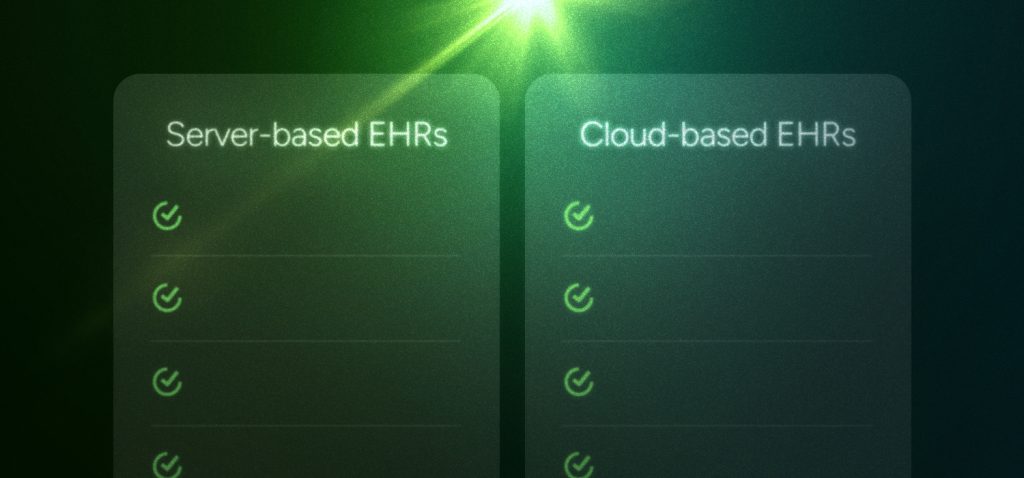
🕐 Read Time: 7 min
Server-based vs cloud-based EHR systems: Which is right for your small practice in the USA?
If you are running a small healthcare practice in the US, choosing the right Electronic Health Record system can feel overwhelming. With healthcare technology changing rapidly, you are probably wondering: should I go with a traditional server-based system or make the leap to cloud-based EHR?
Let me break down everything you need to know about these two main types of EHR systems, so you can make an informed decision that will serve your practice for years to come.
What exactly are EHR systems?
Before we dive into the types, let me quickly clarify what we are talking about. An Electronic Health Record system is your digital filing cabinet for patient records, appointment scheduling, billing, and pretty much everything that keeps your practice running smoothly. Think of it as replacing all those paper charts with a smart, searchable digital system.
Recent studies show over 95 percent of US hospitals and 80 percent of small practices now use some form of EHR system. If you are still on the fence about making the switch, you are definitely not alone, but you are also falling behind the curve.
Understanding server-based EHR systems
A server-based EHR system runs on physical servers located right in your practice. Think of it like having your own private computer network that only your staff can access from your office.
Here is how it works: the software gets installed on servers in your facility, your data stays stored locally on your premises, and access is typically limited to your physical location. Your IT team or hired professionals manage everything from updates to troubleshooting.
The good side of server-based EHR
When you go with a server-based system, you get complete control over your data. Everything stays in-house, which some practice owners find reassuring. You can customize the system to match your exact workflows, and the best part is that it works even when your internet goes down.
Once you pay the initial setup costs, there are no monthly subscription fees hanging over your head. For practices that have been around for a while and have the budget for a big upfront investment, this can make financial sense in the long run.
The performance is also consistent because you have dedicated hardware just for your practice. No sharing computing power with other practices or worrying about vendor server issues affecting your day-to-day operations.
The challenging side of server-based EHR
The biggest hurdle is that initial cost. We are talking about anywhere from 15,000 to 50,000 dollars or more for servers, software licenses, and installation. That is a lot of money for a small practice to shell out upfront.
Then comes the ongoing responsibility. You become the IT department, or you need to hire one. When something breaks at 3 AM, guess who gets the call? When updates need to happen, who is going to handle that? When you need to back up your data, that is on you too.
Remote access is another headache. Want to check patient records from home or the hospital? You will need complex VPN setups that can be frustrating to use and maintain.
If your practice grows and you want to add more providers or open a second location, you are looking at buying more hardware and dealing with more installation complexity.
Who should consider server-based EHR?
Server-based systems make the most sense for established practices with multiple providers, dedicated IT staff, and specific customization needs that cannot be met by off-the-shelf cloud solutions. If you have been running your practice for years, have steady cash flow, and need very specific workflows that require deep customization, this might be your path.
Understanding cloud-based EHR systems
Cloud-based EHR systems work completely differently. Instead of having servers in your office, the software runs on the vendor’s servers in professional data centers. You access everything through your web browser or mobile app, just like checking your email or using social media.
The vendor handles all the technical stuff – updates, backups, security, maintenance – while you focus on patient care. Your data gets stored in secure, professional data centers with redundant systems and enterprise-grade security.
The great things about cloud-based EHR
The most obvious advantage is cost. Instead of dropping tens of thousands upfront, you typically pay between 200 and 800 dollars per provider per month. For a small practice, this is much easier on the cash flow.
You also get automatic updates. Remember those days of waiting months or years for your software to get new features? With cloud systems, updates happen automatically. You wake up to new features and improvements without lifting a finger.
Remote access is built right in. Need to check on Mrs. Johnson’s lab results while you are at the hospital? No problem. Want to respond to patient messages from home? Easy. The system works from anywhere with an internet connection.
The vendor takes care of all the technical maintenance. No more worrying about server crashes, data backups, or security updates. That is all handled by professionals whose entire job is keeping these systems running smoothly.
If your practice grows, adding new providers or locations is simple. No hardware to buy, no installations to schedule. Just update your subscription and you are ready to go.
The downsides of cloud-based EHR
The monthly costs do add up over time. While 400 dollars per month per provider might seem reasonable, multiply that by five providers over five years and you are looking at 120,000 dollars. Sometimes that long-term cost can exceed what you would have spent on a server-based system.
You also need reliable internet. If your connection goes down, you cannot access patient records. In rural areas or places with spotty internet service, this can be a real concern.
Customization is more limited. You get what the vendor offers, and while most systems are quite flexible, you might not be able to create the exact workflows you had in mind.
Some practice owners feel uncomfortable having their patient data stored off-site. While cloud vendors typically have better security than most small practices could implement themselves, the psychological comfort of having data under your own roof is real.
Who should consider cloud-based EHR?
Cloud-based systems are perfect for small to medium practices, new practices just starting out, providers who need mobile access, and anyone who wants minimal IT headaches. If you are running a practice with fewer than 10 providers, do not have dedicated IT staff, and want to get up and running quickly, cloud-based is probably your best bet.

Side-by-side comparison: The numbers that matter
Let me give you a practical comparison. For a typical 5-provider family practice, here is what you are looking at:
Upfront Costs:
Server-based systems will run you 15,000 to 50,000 dollars just to get started. Cloud-based systems typically cost 500 to 2,000 dollars for setup and initial training.
Monthly Expenses:
Server-based systems have minimal monthly costs after setup, but you need to budget for IT support and maintenance. Cloud-based systems run 1,000 to 4,000 dollars per month for five providers, depending on the features you choose.
Time to Get Running:
Server-based implementations take 2 to 6 months from start to finish. Cloud-based systems can be up and running in 1 to 4 weeks.
IT Support Needs:
Server-based systems require dedicated IT expertise, either in-house or contracted. Cloud-based systems include technical support in the subscription fee.
What small practices in the US are actually choosing
Here is the reality: 78 percent of small practices under 10 providers are now choosing cloud-based EHR systems. The trend is clear, and there are good reasons for it.
Dr. Sarah Martinez runs a family practice in Austin, Texas. She told me: “We switched to cloud-based EHR two years ago. Being able to check patient records from the hospital or respond to patient messages from home has been a huge help for work-life balance. I can see lab results come in during my commute and call patients with good news before they spend the whole day worrying.”
The flexibility is what sells most small practice owners. When you are juggling hospital rounds, office visits, and maybe some urgent care shifts, having access to your patient information from anywhere makes a real difference in how you practice medicine.
Meet Edvak: A cloud-based solution built for small practices
Speaking of cloud-based solutions that work well for small practices, let me tell you about Edvak. This is a cloud-based EHR system that was designed specifically with small practices in mind, and I think they got a lot of things right.
What Makes Edvak Different
Edvak runs entirely in the cloud, which means you get all those benefits we talked about: low upfront costs, automatic updates, and access from anywhere. But what sets them apart is how they designed the system specifically for busy practitioners who do not have time for complicated interfaces.
The dashboard is clean and intuitive. You can find what you need without clicking through five different screens. The billing is integrated right into the system, so you are not juggling multiple software programs. Patients can book their own appointments online, which reduces phone calls to your front desk.
The mobile optimization is particularly good. Whether you are using a tablet in the exam room or checking messages on your phone between patients, everything works smoothly across devices.
Security-wise, they handle all the HIPAA compliance requirements without making you jump through hoops. The data is encrypted, the servers are monitored 24/7, and they handle all the technical security updates.
How Edvak Helps Your Practice Run Better
The automated features really add up over time. Appointment reminders go out automatically via text and email, which can cut your no-show rate in half. Insurance verification happens in the background, so you know about coverage issues before the patient arrives.
The voice-to-text feature is surprisingly accurate and can speed up note-taking significantly. Clinical decision support helps with things like drug interactions and preventive care reminders, which is especially helpful when you are seeing 25 patients a day and trying to keep everything straight.
Patient communication is built right in. Secure messaging, test result delivery, and even basic telehealth visits all happen through the same platform. Patients appreciate having one place to manage their healthcare communication.
The reporting features help you track quality measures for programs like MIPS without hiring a separate consultant. The system generates the reports you need and helps you identify areas where you can improve patient care and maximize incentive payments.
Real Results from Real Practices
Practices using Edvak typically see about a 23 % reduction in administrative time and a 31 % improvement in patient satisfaction scores. Those numbers represent real time savings that let you see more patients or just have a better work-life balance.
Dr. Chen runs a small internal medicine practice outside Portland and switched to Edvak last year. He told us: “The time I used to spend on documentation and administrative tasks has dropped dramatically. I can actually leave the office at a reasonable hour most days now, and my patients love being able to schedule appointments online and get their test results through the patient portal.“
Pricing That Makes Sense
Edvak offers four pricing tiers to match different practice needs. The Essential plan starts at $ 299 per provider per month and includes electronic health records, patient portal, online scheduling, standard reports, and basic medical billing. This covers everything most small practices need to get started.
The Plus plan at $ 549 per provider per month adds advanced features like referral management with AI, automated care reminders, command-based reports, and AI-assisted coding. This tier works well for practices that want to automate more of their workflows.
For practices wanting the full suite of capabilities, the Premium plan runs $ 599 per provider per month. This includes multi-location management, AI document interpretation, custom form builder, two-way SMS chat, and customizable dashboards. You also get advanced AI features like conversation capture to structured notes and AI insight actions.
The Enterprise plan offers custom pricing for larger organizations with complex needs. This includes everything in Premium plus dedicated support and custom integrations.
What sets Edvak apart is their approach to features. Even the Essential plan includes AI-powered tools like Darwin for clinical documentation and conversation capture, which many other EHR systems charge extra for or do not offer at all. There are no setup fees, long-term contracts, or hidden costs that can surprise you later.
Meet Edvak: A cloud-based solution built for small practices
Before you choose between server-based and cloud-based EHR, take some time to honestly assess your situation:
What is your budget situation?
Every practice manages finances differently. If you have a budget of around 20,000 dollars available, you could choose to invest in a server-based system upfront. On the other hand, if you prefer to keep your initial expenses lower, you might find monthly payments a more comfortable option. For instance, with Edvak’s Essential plan at 299 dollars per provider per month, a three-provider practice would spend about 900 dollars monthly with no upfront hardware costs.
How comfortable is your team with technology?
Every practice has a different level of technical expertise. If you have staff who can easily handle computer troubleshooting, managing your own IT infrastructure may be a good fit. However, if technical maintenance feels overwhelming or takes focus away from patient care, a cloud-based system like Edvak can manage the technical work behind the scenes for you.
How important is remote access?
Are you doing hospital rounds? Do you want to check messages from home? Do you travel between multiple practice locations? If mobility matters to your practice style, cloud-based systems have a clear advantage. Modern systems make it easy to access patient records securely from anywhere.
How much customization do you really need?
Be honest about this one. Most practices think they need more customization than they actually do. Standard workflows work for the vast majority of medical practices. Many cloud-based systems now offer enough flexibility to handle most specialty requirements without the complexity of custom programming.
What are your growth plans?
If you are planning to add providers or open additional locations in the next few years, cloud-based systems will make that expansion much smoother. Adding a new provider to a cloud system is as simple as updating your subscription, while server-based systems require new hardware and complex installations.
After considering these questions, if you find yourself leaning toward cloud-based EHR, it might be worth seeing how a system like Edvak would work with your actual practice workflows. They offer free demonstrations where you can test the system with real scenarios from your daily routine. Book a demo to know more
Takeaway for small practices
For most small practices in 2025-26, cloud-based EHR systems offer the best combination of value and flexibility. The lower upfront costs make them accessible to newer practices, the automatic updates keep you current with the latest features, and the remote access capabilities fit the way medicine is practiced today.
Server-based systems still make sense for some practices, particularly larger ones with dedicated IT resources or very specific customization requirements. But for the typical small practice, cloud-based solutions like Edvak provide the right balance of functionality, affordability, and ease of use.
The healthcare industry is moving toward more connected, mobile, and patient-centered care delivery. Cloud-based EHR systems position your practice to be part of that evolution rather than trying to catch up later.
Ready to make your move?
Choosing an EHR system is one of the most important technological decisions you will make for your practice. Whether you go with server-based or cloud-based, make sure you demo multiple systems before deciding, check references from practices similar to yours, understand all the costs including training and support, verify compliance with your specific requirements, and plan for migrating data from your current system.
The good news is that both server-based and cloud-based EHR systems are more mature and reliable than they were even five years ago. Either choice will likely be a significant improvement over paper records or older digital systems.
If you want to see how a modern cloud-based system like Edvak might work for your practice, they offer free demonstrations where you can test the system with your actual workflows. Hundreds of small practices across the US have made the switch to more efficient EHR management, and the results speak for themselves: less time on paperwork, more time with patients, and a practice that runs more smoothly from day to day.
The question is not really whether you should upgrade your EHR system, but when you are going to make the move and which system will serve your practice best for the next decade of healthcare delivery.
Frequently Asked Questions About EHR Systems
What is the main difference between server-based and cloud-based EHR?
Server-based systems run on computers in your office that you own and maintain. Cloud-based systems run on the vendor’s computers, and you access them through the internet. The biggest practical differences are upfront cost, who handles maintenance, and how easy it is to access records from outside your office.
How much should a small practice budget for EHR?
Cloud-based systems typically cost 200 to 800 dollars per provider per month, plus 2,000 to 10,000 dollars for setup and training. Server-based systems cost 15,000 to 50,000 dollars upfront, plus ongoing IT costs. Most small practices find cloud-based more manageable for cash flow.
How long does it take to implement a new EHR system?
Cloud-based systems usually take 1 to 4 weeks to get running. Server-based systems typically take 2 to 6 months because of hardware installation and more complex setup requirements. The exact timing depends on how much data you need to migrate and how much training your staff needs.
Can I access my EHR from home or the hospital?
Cloud-based systems are designed for access from anywhere with internet. Server-based systems can be set up for remote access, but it requires additional technical configuration and can be more complicated to use securely.
What happens to my data if I want to switch EHR systems?
You should own your patient data regardless of which system you choose. Most EHR vendors can export your data in standard formats, though the process can be complex and costly. This is why choosing the right system upfront is important, but it is not impossible to switch later if needed.
How does Edvak support small practices with EHR systems
Edvak provides HIPAA compliant cloud based EHR solutions that reduce IT complexity, improve accessibility, and lower costs for small practices in the United States.
What type of medical practices benefit most from Edvak cloud based EH
Small and mid sized practices that want predictable pricing, vendor managed compliance, and remote access benefit most from Edvak cloud based EHR.
Can Edvak EHR scale as a small practice grows
Yes, Edvak cloud based EHR is designed to support small practices today and adapt as patient volumes, staff size, and regulatory requirements expand over time. To know about how we help small practices, book a demo now.
Ready to take the next step?
Get a personalized demo and see how Edvak can drive real impact to your practice.
Related Blogs
More Categories
Edvak.com Terms & Conditions Privacy Policy © 2025 Edvak. All rights reserved.



